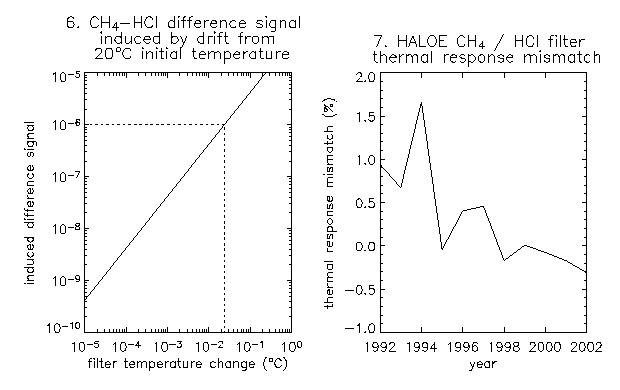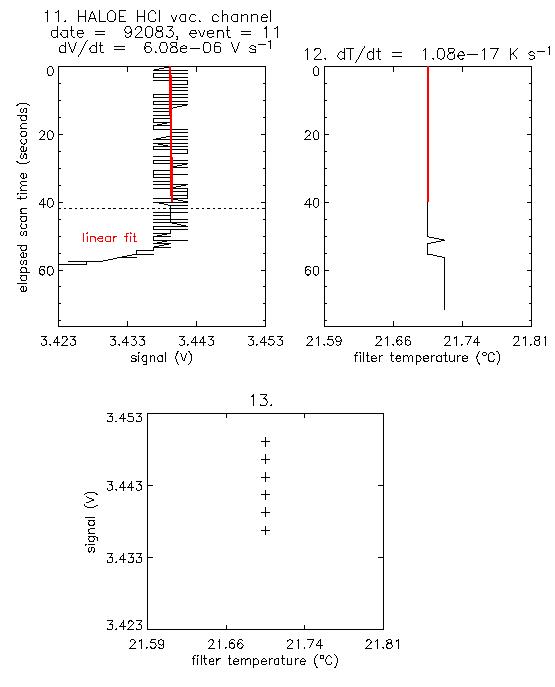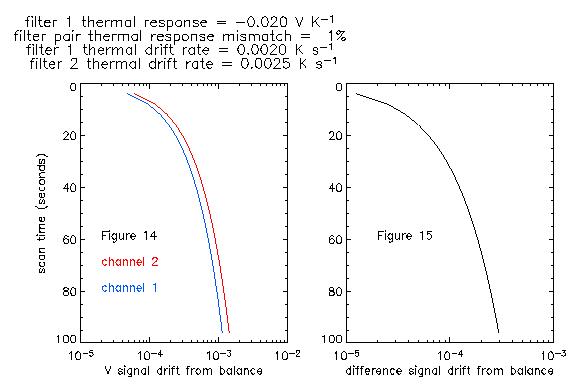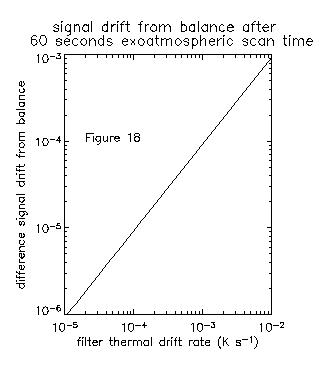Thermal Stability and SOFIE Measurements

Changes in instrument temperature can affect the measurements in a
variety of ways. Some important considerations are outlined below.
1. Detector response
Changes in detector temperature can affect their performance.
2. Spectral filter response
Temperature changes can cause changes in filter position,
opacity, and width.
3. Beam Steering
Temperature changes in the optical components can alter their
characteristics and cause the beam to move slightly out of alignment.
Known as "beam steering", this effect can induce drift
across a non-uniform detector, or intensity variation due to
non-uniform optics.
4. Chopper Stability
Thermal changes can affect the behavior of the chopper.
The above affects generally manifest themselves as signal drift that is
correlated to instrument temperature. Signal drift can be
understood through analysis of flight data and removed during data
processing.

Analysis of instrument temperature effects
using HALOE flight data
HALOE performs exo-atmospheric solar scans as part of each measurement
event. Because the distance and angle between satellite and sun
vary over time, the instrument experiences varying solar
intensity which results in a range of instrument temperature.
Because the
target solar intensity is fairly constant over short periods of time,
changes in the measured peak solar intensity are assumed to
result from changes in instrument temperature. Thus, the
exo-atmospheric solar scan data provide a means for understanding the
effects of instrument temperature on instrument response.
Figure 1 below (Figure numbers on top) shows the relationship between
filter temperature and peak signal in the CH4 V channel,
for all HALOE events during 1992. These data indicate a
linear relationship between filter temperature and detector voltage.
The induced transmission due to filter temperature change was
determined
using the HALOE CH4 V measurements (Figure 2). For this purpose,
the induced transmission is determined as the ratio of voltage at
some temperature to the voltage at the initial temperature. These
results indicate that a thermal change of about 2e-4 degrees C will
induce
a transmission equal to the expected SOFIE measurement noise (1e-6).
Figures 3 and 4 shows similar results as in Figures 1 and 2,
except
for the HALOE HCl V channel. The HCl channel response to thermal
drift is very similar to that of the CH4 channel.

Thermal stability for the SOFIE difference signal measurements will
depend on how well the thermal dependence of filter pairs are
matched. Figure 5 shows a theoretical calculation of the thermal
drift that will induce a difference signal of 1e-6, as a function
of the thermal mismatch between filter pairs. For this purpose
filter
response mismatch is defined as the difference in slope of the signal
vs.
temperature curves (e.g. Figure 1). An important point here is
that
the thermal stability of a single filter does not matter as long as
band
pair filters have similar thermal response characteristics.

The HALOE HCl and CH4 channels were used as proxies to estimate
expected thermal drift induced difference signals for SOFIE band pairs.
The HCl and CH4 channels are close in wavelength, with band
centers at 3.40 and 3.46 microns, respectively. This
separation is generally smaller than the separation between most SOFIE
band pairs. HALOE data for 1992 (Figures 1 and 3) were used to
derive the CH4 - HCl difference signal induced by thermal drift from an
initial temperature of 20 deg. C (Figure 6). The induced
difference signals are less than 1e-6 for temperature changes of less
than about 0.02 degrees C.
The thermal response mismatch between the HALOE CH4 and HCL channels is
shown for 10 years of the HALOE mission in Figure 7. These
results
indicate that the HALOE filter characteristics have remained very
stable,
with thermal mismatch generally less than 1% between these two
channels.
The HALOE HF and CO2 channels are farther apart, at 2.45 and
2.80 microns, respectively. These channels were also used
to characterize pseudo band pair difference signals induced by thermal
drift, and should represent a worst case scenario. For
these
channels a difference signal of 1e-6 is induced by roughly 1e-4 degrees
C of thermal drift.
Signal and filter temperature drift rates were examined for the
exoatmospheric portion of HALOE occultations, for high and low
beta angles (the
angle between the orbit plane and earth-sun vector). SOFIE will
experience beta angles less than +/- 6 degrees. Heating rates are
highest for high beta angles, and thus represent a worst case
scenario that SOFIE will not experience. Exoatmospheric HCL
channel signal and filter
temperature profiles are shown in Figures 8 and 9 for one HALOE event
at
high beta angle (-60 degrees). These data are shown versus
elapsed
scan time, which is equivalent to altitude. The
exoatmospheric
drift rates in V and filter temperature were -3.3e-5 V/s and 1.2e-3
K/s,
respectively. Figure 10 shows that the dependence of V on T
(about
0.027 V/K) for this scan was similar to the 1992 average shown in
Figure
3 above. Exoatmospheric HALOE data for one event at low beta
angle
(-3 degrees) are shown in Figures 11-13. These measurements show
negligible
drift in V and filter temperature, and no discernible
relationship
between V and T (Figure 13). These results should be more
representative
of SOFIE occultations.



HALOE measurement characteristics were considered in simulations of the
signal drift induced by thermal change during an occultation. In
this exercise, the important instrument characteristics are 1)
the thermal response of a filter (V vs. T, e.g., Figure 1),
thermal response mismatch for a filter pair (e.g., Figure 7),
thermal drift rate for a filter, and thermal drift rate
difference for a filter pair. HALOE scan data show that the
exoatmospheric drift rate for the HCL filter temperature is on the
order of 2e-4 K/s, and that the CH4 filter temperature drift rate
is roughly within -30% to 30% of the HCL filter drift rate. As
shown above, the HCL and CH4 channel thermal response is on the
order of 0.02 V/K, and that these channels exhibit thermal
response mismatch of less than 1%. These characteristics were
used to construct a theoretical scan, with the goal of
determining the signal and difference signal drift from their initially
balanced conditions. Results considering
thermal drift of 0.002 K/s and 0.0025 K/s for filters 1 and 2 (Figures
14
and 15) show that after about 1 minute of exoatmospheric scan time the
single
detector signals drift by about 1e-3 of the balanced signal, and
that
the difference signal drifts by about 1e-4 of the balanced signal.
Using
filter temperature drift rates of 0.0002 and 0.00025 for filters 1 and
2
(closer to HALOE measurements at low beta), reduces the signal
drifts
by roughly an order of magnitude (Figures 16 and 17).
The difference signal drift after 60 seconds exoatmospheric scan time
versus
the thermal drift rate of filter 1 is shown in Figure 18. For
these
calculations, filter 2 had a thermal drift rate equal to 25% of
that
for filter 1. The thermal response of filter 1 was set to 0.02
V/K,
and the filter pair thermal response mismatch was 1%. The
difference
signal drift is reduced when the thermal drift rate is low, and
is
near the desired level for SOFIE (1e-4 of balance) for a drift rate of
0.001
K/s (0.06 K in one minute).



If the SOFIE filter characteristics are similar to HALOE, then
the results presented here provide some guidance in predicting the
effects of thermal instability on SOFIE measurements. Based on
the analysis below, the temperature change inducing a difference
signal of 1e-6 is probably less than 0.02 deg C. A single
detector signal of 1e-6 is induced by a thermal change of roughly 2e-4
deg. C. In any case, signal drift induced by thermal
instability can be characterized in flight data by analyzing the
exo-atmospheric portion of a scan to determine a drift rate which can
be removed from signals before the retrieval of science data.









